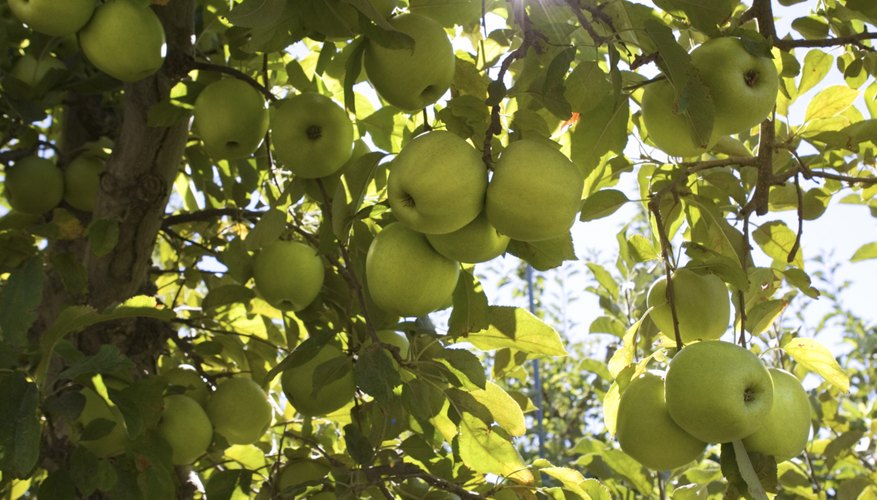Vegetative propagation is the art of using cuttings, stooling, budding or other methods to produce a replica of the parent plant. Open pollination and simple evolution will often produce fruit trees that are not true to the parent's characteristics. To prevent this mutation gardeners use asexual propagation methods like cutting and grafting. Three main types of cuttings that can be taken from your fruit trees. The cutting type you choose depends on the type of propagation you will be doing and the type of fruit tree you have. Citrus are propagated from softwood cuttings, apples, pears and plums from hardwood cuttings. Budwood cuttings can be used with several types of fruit trees. Taking fruit tree cuttings and grafting or rooting them allows the home gardener to reproduce fine fruit tree varieties without purchasing more trees.
Take budwood cuttings for T-budding in mid-June when bark "slips" (separates easily from the inner wood of your fruit tree). Gather the bud cuttings from vigorously growing shoots of the current season's growth.
According to Geoff Bryant in his 2003 book, "Plant Propagation A to Z", you should look for a healthy leaf with a firm, plump bud at the leaf axil. Cut off the leaf leaving a stub that you can use to hold and manipulate the bud while grafting.
Using a sharp knife, slice into the wood at an angle ½ to ¾ inch below the chosen bud. Draw the knife up under the bud and cut until ½ to ¾ inch above the bud. Make a cut across the stem at this point and peel the bud from the stem.
Peel the bud back, taking only the cambium layer (the thin layer between the sapwood and bark) with it. Too much wood prevents implanted buds from taking quickly. Cut or peel away excess wood.
Place the budwood cuttings on damp paper towels and roll up gently if making several cuttings. Use budwood cuttings right away or very shortly after taking them.
Take softwood cuttings in the late spring or early summer from new growth. Use healthy, vigorous plants for cuttings and avoid wilted or obviously insect infested fruit trees. Take cuttings just before you plan to use them.
Test to see if you have true softwood. According to Miranda Smith in her 2007 book, "The Plant Propagator's Bible", bending branches at a 90 degree angle 6 inches from the tip will tell you whether you have softwood. "Hardwood won't bend at all, and branches that are too young to cut won't break."
Cut a 4 to 6 inch section from stems that have stopped growing at the tips but haven't hardened completely yet. Make a 45 degree cut 1 inch below the spot where a leaf joins the stem.
Remove all but the top two leaves from the cuttings and roll the ends up in wet paper towelling. Put the cuttings in your container. Cuttings should be planted immediately after you have taken as many as you need.
Dip the tips of the cuttings in rooting hormone after removing from the wet paper towelling and before planting.
Taking Hardwood Cuttings
Take hardwood cuttings, called scions, in late fall when your fruit trees have gone dormant.
- Take hardwood cuttings, called scions, in late fall when your fruit trees have gone dormant.
Choose one-year old wood that is vigorous and not diseased or insect infested. Use the thinner wood at the ends of the one-year-old growth. Scions should be as big around as a pencil, or at most ½ inch thick.
Cut scions 8 to 12 inches long by making a straight cut just below a growth node. Make a 45 degree angled cut above a node near the tip to remove soft wood.
Make small bundles of 6 to 8 cuttings by tying them together with garden twine. Wrap the cutting bundles with moist (not soaking) peat moss. Put your wrapped scion bundles into plastic bags.
Put the date cuttings were taken, the type of fruit tree, and the variety name on a label and attach it to the scion bag.
Put the scion bags into the refrigerator to cool and callus over winter. Keep them away from fruits and vegetables in the refrigerator.
TIP
Water sprouts can be used for scionwood cuttings. Wound hardwood cuttings from species of fruit trees that are hard to root. Make a 45 degree angle cut starting 1 inch above the base of the cutting and continuing down to the base. This exposes more surface area to callus and grow roots. Apply rooting hormone to hardwood cuttings before planting in sprouting beds or containers.
WARNING
Budwood should not be taken from a diseased tree or from shoots with feeding insects or insect damage. Do not take cuttings from branches or shoots that are "sports" having different characteristics than the rest of the fruit tree you want to propagate. The University of Georgia Cooperative Extension in their 2009 bulletin, "Propagating Deciduous Fruit Plants Common to Georgia", warns against storing scionwood near picked fruits and vegetables. Scionwood can be killed by the produce outgassing ethylene.
